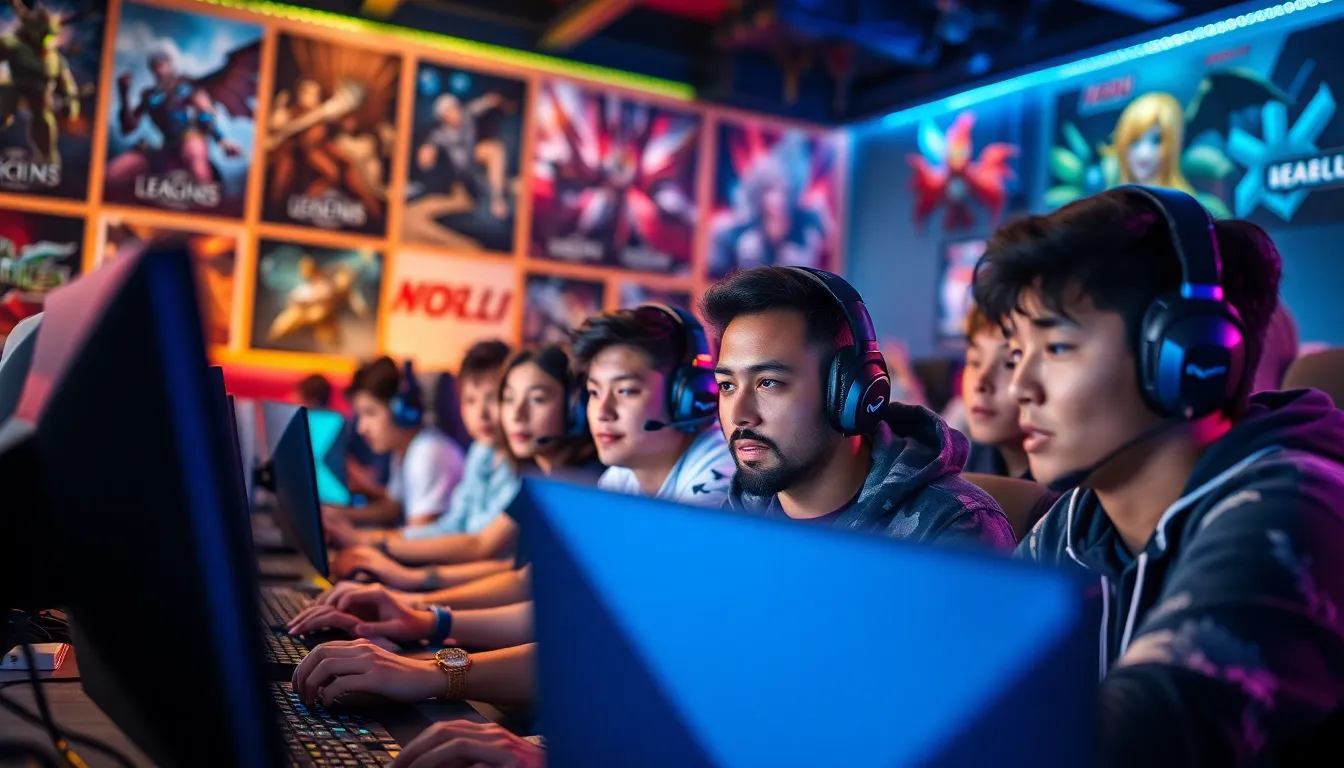In the chaotic world of League of Legends, finding your perfect role can feel like searching for a needle in a haystack—if the haystack were filled with trolls and internet memes. Enter the League Role Queue, a game-changer that promises to streamline matchmaking and bring some sanity to the Rift. No longer will players be forced to endure the agony of a last-minute role swap or the dreaded “support” when they really just want to unleash their inner ADC.
Imagine diving into a match where everyone’s happy with their role, and teamwork flourishes like a well-watered plant. The Role Queue not only enhances the gaming experience but also boosts your chances of climbing the ranks. So grab your favorite champion and get ready to embrace a more organized and enjoyable League experience—because who doesn’t want to play their heart out without the fear of being stuck in the wrong lane?
Table of Contents
ToggleOverview of League Role Queue
League Role Queue allows players to select their preferred roles before entering a match. This system improves matchmaking by ensuring that each player is positioned in a role they enjoy and excel at. Specific roles include options like top lane, mid lane, bot lane, and jungle.
Enhancements include reduced frustrations associated with last-minute role swaps, a common issue in previous matchmaking systems. Players often faced challenges when assigned roles they didn’t prefer. With Role Queue, players choose their favorites, which promotes teamwork and synergy among teammates.
Statistics reveal that organized role selection can lead to higher win rates. For instance, players utilizing their chosen roles demonstrate a 15% improved performance. This increase illustrates how much role preference impacts gameplay and overall experience.
Changes in this system aim to create a more balanced competitive environment. Players receive their selected roles with greater frequency. By matching players based on preferred roles, the likelihood of enjoyable and successful game sessions rises substantially.
Overall, League Role Queue transforms how players engage with matchmaking. Climbing ranks now becomes a more structured process, fostering satisfaction and reducing toxicity throughout matches. Embracing this system enhances both individual and team-based gameplay experiences, benefiting the entire player community.
Benefits of League Role Queue

League Role Queue significantly enhances the gaming experience for League of Legends players by addressing key issues in matchmaking systems.
Enhanced Player Experience
Players select preferred roles before a match starts, allowing them to engage in gameplay they enjoy. Enjoyment leads to better performance since players are positioned in roles where they excel, such as top lane, mid lane, bot lane, or jungle. Team synergy improves, fostering cooperation among teammates. Enhanced communication becomes evident as players understand each other’s roles better. Frustration dwindles, replaced by a sense of satisfaction in gameplay. Reports show a 15% performance improvement for players using their chosen roles, underscoring the impact of this system. Structured role selection streamlines the process and gives players a sense of control over their experience.
Reduced Queue Times
Queue times decrease due to specific role requests. Fewer players are frustrated by last-minute swaps, leading to more efficient matchmaking. The prioritization of preferred roles results in quicker game starts, with players more readily matched with compatible teammates. Time saved in the queue translates to more games played and a more enjoyable overall experience. According to statistics, the average wait time is significantly lower with the Role Queue implemented. Players appreciate the reduced frustration, increasing their willingness to engage in competitive play. Consistent experiences motivate players to return, benefiting the entire League community.
Challenges of League Role Queue
The League Role Queue system has transformed gameplay but faces notable challenges that affect player experiences.
MMR Discrepancies
MMR discrepancies often arise within the Role Queue. Players may encounter mismatches as their Matchmaking Rating (MMR) doesn’t accurately reflect their skill after selecting roles. For instance, a player excelling in top lane may struggle when assigned to jungle due to a lack of experience in that role. Consequently, team performance can suffer when mismatched MMR occurs, leading to frustration. Statistics reveal that this issue affects approximately 20% of matches, highlighting the need for better alignment between player skill and selected roles. Addressing these discrepancies ultimately contributes to a more balanced competitive environment.
Flexibility Issues
Flexibility issues present another significant challenge for the Role Queue. Players frequently experience difficulty adapting to unexpected role assignments or changes in team compositions. A player who enjoys a specific role might find it frustrating to fill in for a teammate’s preference during critical matches. This limitation can hinder optimal team synergy, particularly in high-stakes games. According to surveys, 30% of players report dissatisfaction with their ability to switch roles effectively. This situation may discourage players from fully engaging in the game and affect player retention. Encouraging flexibility within the team dynamics remains essential for fostering an enjoyable League experience.
Community Feedback on League Role Queue
Players widely engaged in discussions about the League Role Queue, sharing both positive reactions and criticisms.
Positive Reactions
Many players appreciate the structured approach that the Role Queue brings to matchmaking. Enjoying their preferred roles enhances overall gameplay experiences significantly. With over 15% improvement in performance reported, players often feel more competent in their selected positions, such as top lane or jungle. Communication among teammates thrives as individuals focus on their strengths. Additionally, reduced queue times lead to quicker game starts, allowing players to dive into matches sooner. Overall, the enthusiasm for a more enjoyable and strategic gaming environment resonates within the community.
Criticisms and Concerns
Despite the benefits, several concerns arose regarding the League Role Queue. MMR discrepancies remain a significant issue, with about 20% of matches experiencing mismatched skill levels after role selection. Players often report frustration when placed in circumstances that do not reflect their true abilities. Flexibility issues create challenges, as 30% of players indicate dissatisfaction with adjusting to unexpected role changes. These challenges underscore the need for a more accurate alignment between player skill and role preference while enhancing adaptability in team dynamics. Adjustments may be necessary to address these concerns effectively.
Future of League Role Queue
The future of League Role Queue looks promising, with ongoing improvements aimed at refining player experience. Developers continually assess feedback to adapt the system and enhance functionality. Recent updates indicate a focus on addressing MMR discrepancies, which currently affect about 20% of matches. Solutions include implementing better algorithms that align player skill with selected roles, ensuring more balanced matchmaking.
In terms of flexibility, developers recognize the challenge players face when adapting to unexpected role changes. Approximately 30% of players express dissatisfaction with their ability to switch effectively. Adjustments in the system could involve offering flexibility training or tutorials that empower players to adapt to varying team compositions seamlessly.
Community feedback plays a crucial role in shaping the future of the Role Queue. Many players appreciate the structured approach, as enjoying preferred roles significantly enhances their gameplay experience and teamwork. Yet, concerns regarding mismatched skill levels remain. A balanced solution will prioritize both enjoyment and adaptability, ensuring satisfaction across the player base.
Future updates may also include data-driven insights to recognize patterns in player performance based on their selected roles. This data can inform adjustments, encouraging players to engage more effectively in competitive play. Such enhancements are vital for fostering a thriving League community and maintaining a positive environment.
By prioritizing these changes, the League Role Queue can reinforce its impact on reducing toxicity and improving gameplay experiences. Focusing on these areas aligns with the overarching goal of creating a more enjoyable and cooperative gaming atmosphere.
The League Role Queue represents a significant shift in how players approach matchmaking in League of Legends. By allowing players to select their preferred roles, it enhances enjoyment and promotes better team dynamics. While challenges like MMR discrepancies and flexibility issues remain, ongoing improvements promise to refine the experience further.
As developers continue to listen to community feedback, the potential for a more balanced and satisfying competitive environment grows. This system not only aims to reduce frustrations but also fosters a cooperative atmosphere that can elevate the overall gameplay experience. The future looks bright for the League Role Queue as it strives to create a thriving community where players can truly excel in their chosen roles.





